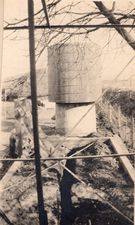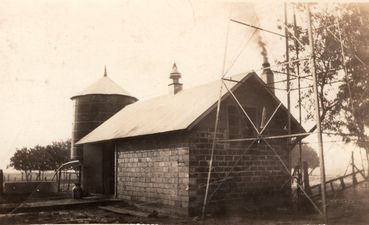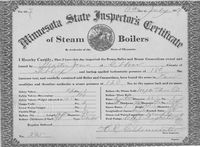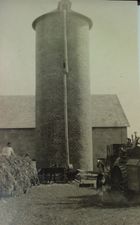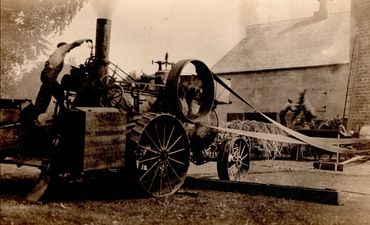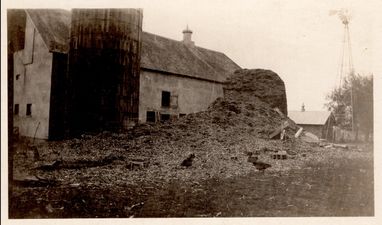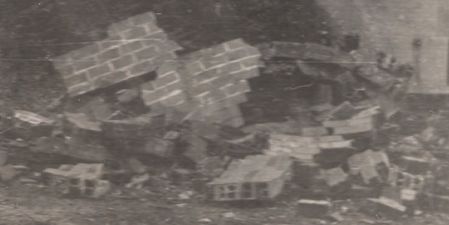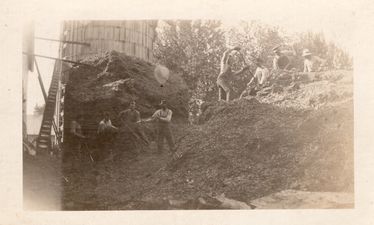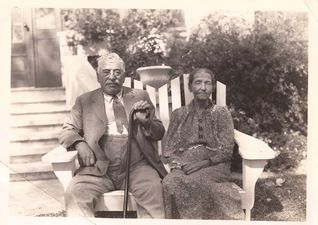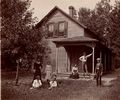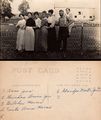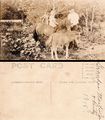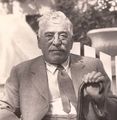Category:Jaus Farm
From CowTales
View information about this location on Wikipedia at: Google Search
The Jaus Farm was homesteaded in 1882 by Martin Jaus Sr. He was able to get 160 acres of Sibley County prairie in exchange for planting 10 acres of trees. He housed his family in a two story log cabin. The farm flourished under Martin Sr. His farm included a creamery and silos. A new house and new barn were later be added to the farm. Multiple generations of Jaus's have lived on the farm. To date, the farm has been passed down through four generations<ref> (Martin Jaus Sr., Martin A. Jaus, Roman Jaus, and Martin Allen Jaus)</ref>.
Contents
Time Line
- 1878 - Homesteading in MN opens up.
- 1880 - Silos first introduced to MN. Before WWII most silos were 12' -14' wide and 35'-40' tall providing feed for about 25 cattle under average conditions.
- 1882 - Comes to Moltke township <ref>File:1939 - Martin Jaus Sr newspaper death announcement.jpg</ref>
- 1882 - Martin Sr. works as a hired hand.
- 1883 - Builds 1st two floor family log cabin home.<ref>Myrtle Jaus notation on picture</ref>
- 1884 - Martin Sr. and Louise Harms marry
- 1885 - Lydia Jaus born.
- 1885 Centrifugal Cream Separator becomes available in MN.
- [[ ]] - Builds 1st barn.
- 1887 - Otto Jaus born.
- 1889 - Anna Jaus born.
- 1892 - Martin A. Jaus born.
- 1893 - Herbert Jaus born.
- 1896 - RFD (Rural Free Delivery) mail system established.
- 1898 - MN had 557 co-op creameries (84% of all creameries). Twenty years later MN had 671 c0-0p creameries, just under half of all the creameries in the nation.
1899 - Original Jaus Log cabin in built in 1883
This is the original log cabin used by the Martin Jaus Sr. family from 1883-1905 when the big farm house was built. It is my understanding the house was turned into a chicken coup.
1889 Martin Jaus Sr. family in front of original log cabin built in 1883 on Jaus Farm.
Left to right:
- Martin Jaus Sr. age 41
- Louise Harms age 39
- Lydia Jaus age 14
- Anna Jaus age 10
- Otto Jaus age 12
- Martin Jaus age 7
- Herbert Jaus age 5
source:Myrtle Jaus collection
- Prior to WWI most MN dairy herds were made up of common red cows.They didn't produce milk high in cream content.
- 1900- Golden age of agriculture begins.
1905 Farmhouse
- 1905 - Builds big farmhouse. The success of the creameries is evident as the log/sod shanties of the early settlers gave way to new spacious homes. (Martin Sr. age 47, Martin A. Jaus age 13)
- Before WWI most farmhouses didn't have plumbing etc. (Farm house built 1905)
- 1905 - Cement silo staves introduced.Cement stave silos have towered over the Minnesota landscape since 1905
- 1908 - Lydia Jaus andEdward Scheele marry.
- 1908 - Ford Model T introduced.
- 1908 - First structural clay tile silo built.
1910 - The Creamery
- Built after 1905 farm house.
- The success of the creameries is evident as the log/sod shanties of the early settlers gave way to new spacious homes.(must be referring to the early co-op creamery.
- A creamery became an important farm building in the 1920s.
- Milking cows and raising pigs were companion enterprises because dairy farmers sold their cream to the butter factory (also called creamery) and fed the byproduct, the skim milk, to the hogs.
- Some farmers took the whole milk to the co-op creamery.
- Eventually, farmers started separating the milk and cream on the farm.
- Eventually, the co-op creamery only accepted the separated cream.
- Brick was most often used for farm houses (see Harms house) and fire proof structures like smoke houses. However it was also used for other structures like milk houses if quality brick was nearby. New Ulm, MN had good bricks.
- It appears this creamery was built of the same material, "structural clay tile", as the silo which collapsed. This material was used quite a bit in the 1910s and buildings were still good in the 1940s.
- I don't know if 1910 is the exact year the creamery was built, but it seems to be a close match based on history and other pictures. Most farmers took there milk to the local creamery each day in 1910.
- After 1870 the MN butter market/production took off for a 30 year expansion. No other state had "cornered" the butter market like WI had the cheese market.
- The creamery was built about 1910.
- It is constructed using the same "structural clay tile" as the silo seen.
- We know the creamery was built after 1905 because the 1905 farmhouse can be seen in the background.
source:Myrtle Jaus collection.
The creamery was built about 1910. The creamery was used to separate cream from the milk.- In 1885 Centrifugal Cream Separator<ref>I remember Mark Hinderer using a separator when I was a kid.</ref> became available in MN.
- The milk and cream were stored in 10 gallon water cooled milk cans.
- Note how the creamery was built right next to the windmill which pumped cold water directly from the 80' deep well<ref>Gerald Jaus memory</ref> into the creamery cooling tank. The water then flowed into a water holding tank used for watering livestock.
- See the hand pump under the windmill and the tin cup hanging from a windmill bracket? Also note the large milk can near the creamery door. It looks bigger round than the Jaus milk can I have.
source:Myrtle Jaus collection.
<references/>
<references/>
- 1910s - Silo filler being used in WI in 1910
- 1912 - Jaus Case Steam tractor. Tractors were being used and threshing machines. Most farmers shared machines.
- 1912 - Picture of steam tractor and threshing machine.
- 1914 - Silos are a normal, although not all farms had one.
- 1914 - 'Picture' of Model T, Ed, Lydia, Roland Scheele and others.
- 1914 to 1918 - World War 1.
- 1910 - Cement silo staves proliferated.
- 1917 - Martin Jaus Sr. selling cream to the Gibbon Creamery Co-op.
- 1917 - Otto Jaus and Anna Friedrichs marry.
- 1917 - Anna Jaus and Henry Gruenhagen marry.
* 1917 - Martin A. Jaus gets steam engine certification.
- 1918 - MN had 671 co-op creameries, just under half of all the creameries in the nation.
- 1918 - Cars purchased and roads actively improved.
- 1919 - Martin A. Jaus and Hannah Lieske marry. Martin Sr. was age 61
- 1919- Golden age of agriculture ends.
- 1920 - The bubble of prosperity broke and farmers entered a 20 year depression.
- 1922 - The popular Surge Bucket Milker was invented.
- 1924 - Land O' Lakes brand launched.
- 1925 - Norbert Scheele funeral.
1925 Filling the Silo
The silo had almost become a basic necessity 1914. It greatly increased the amount of milk/cream a farmer could produce per year. A silo at the farm collapsed during filling. Myrtle Jaus guesses the date to be around 1925.
- Silo filler being used in WI in 1910
- Silo filler used in MN for the first time in 1925.
- Steam tractor is a 1912 Case.
- Up to three men were often needed to feed the silo filler. Many hands were lost when they got stuck in feed. Using a stick to push the feed into the cutter/filler was a lot safer, but not as fast.
- Some silo filling was done by crews who went from farm to farm. I know the Jaus farm employed several hired hands.
source:Myrtle Jaus collection.
- Up to three men were often needed to feed the silo filler. Many hands were lost when they got stuck in feed. Using a stick to push the feed into the cutter/filler was a lot safer, but not as fast.
- Three wagons and teams of horses were kept busy doing silo filling time. One being filled in the field, one being emptied at the sile, and one either coming or going to the field. Marvel Jaus drove the wagons until Lyla Jaus was old enough to replace her in the early 40s.
- I always imagine the wagon loads were quite large. It would take a LOT of trips using carts the size we see in these pictures.
- Martin A. Jaus could be the one on the tractor. He was 33 at the time and had his name on the steam engine certificate.
1925 Silo Collapse
The original silo on the farm collapsed around 1925. I'm not sure when it was first constructed, but the first MN structural clay silo was built in 1908. I am positive this was built using structural clay tile. This sooner than the first sillage filler was used in MN. I'm thinking Martin Jaus Sr. must have been looking ahead when he had it built.
I don't know if the silo collapsed the first time they used the filler. It had to be one of the first times.
1925 - Jaus Farm Silo Collapses during filling. Note how the sides of the silo on the left are stained. I believe this was the second silo put up on the farm. It is made of a different type of construction from the others. It almost looks like a wood slat silo and could have been used to overflow storage.The small building on right was the creamery. They made butter. Martin A. Jaus attended butter making school in Austin, MN.
source: Myrtle Jaus collection.
Collapsed silo rubble on Jaus Farm. Notice the silo filling tube on the ground. The silo on the left doesn't have a roof. I believe it came off when the other silo collapsed.The far right end of the barn is where the new silo will be built. See the wire running up the the wall past the windows up to the lightning rod on the roof?
source: Myrtle Jaus collection.
Men with pitchforks are cleaning up the mess from the collapsed silo. This picture was a bit difficult to figure out. It appears the cement stave silo in the background was built after the collapse, but before the cleanup. It is built on the end of the barn. A small add on would be built where the old silo once stood.You can see the creamery in the background. The view is from where the old silo stood, looking between the new silo and the barn wall on the left. Note the openings on the left of the silo. These are entry doors used for emptying the silo. A short connection building would be built between the silo and the barn.
source: Myrtle Jaus collection.
- 1925 - The first MN silo filler was developed around 1925.
Richard Bentz Jim Baur Sorry about the delay in responding...I wanted to do some research about the silos. The one on the right is a 'Ribstone'. The staves were from the 'Artstone' company in New Ulm. I am guessing the one on the left is a 'standard style' stave silo. I have no idea as to when they may have been built. I was part of a 'crew' that filled silos during the late 60's and early 70's
- 1927 - First combine harvesters used in state.
- 1927 - Big barn built.(Martin Sr. age 70, Martin A. Jaus age 36)
- 1929 - Only 4% of farms used electricity.
Martin Jaus Sr. and Loise Harms 50th Anniversary
- 1934 - Martin Sr. celebrates 50th wedding anniversary.
- 1935 - Farms didn't get electricity until 1935 and most not till the 1950s.
- 1935 - Hannah Lieske funeral.
- 1939 - Martin Sr. funeral.
- 1940 - Louise Harms funeral.
- 1940 - All of St. Peter's wired for electricity and NSP built a line. Organ installed an electric blower.
Notes
- Karla Jean Jaus: A neat feature in the barn was that the haybarn had a multi level granary, this was above what we used as the chicken barn and later was used for pigs. The slate roof had the slates put on in at an angle and on the side facing the pasture, they used light colored slate shingles to print Jaus Holstein Farm. The contrast in color had diminished quite a bit when I was a kid but I often thought about those workers on the barn getting all those heavy slates on the correct placement while doing the roofing.
- Before WWII most silos were 12' -14' wide and 35'-40' tall providing feed for about 25 cattle under average conditions
Farming Study Resources
MN Historic Farm History: Individual Farm Elements
Historic Contex Study of MN Farms 1820-1960
Historic Context Study of Minnesota Farms 1820-1960 home page
* Vol 1
* Vol 2
* Vol 3
=MN Historic Farms Study: Focus on Government Land Programs
<references/>
- Search Google Maps with New Ulm, MN as the starting location.
- MN Historical Society
- Search Map Carta
- MN History & Vintage Pictures by City
- MN Historical Society
- Carver County Historical Society
- Renville History site
- Washington History
- The History of Renville County, MN] PDF
- Historical Context Google Search
- Historic Context Study of Minnesota Farms 1820-1960 home page
Subcategories
This category has the following 3 subcategories, out of 3 total.
Pages in category "Jaus Farm"
The following 6 pages are in this category, out of 6 total.
Media in category "Jaus Farm"
The following 54 files are in this category, out of 54 total.

